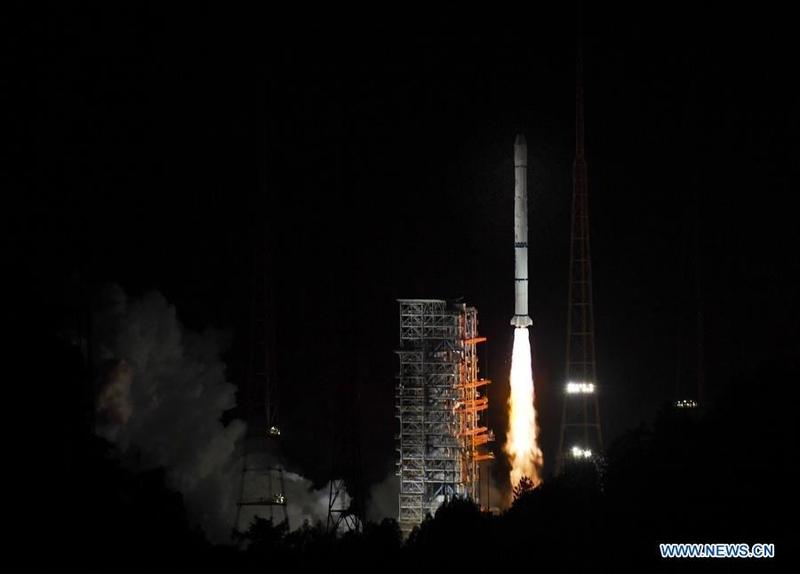 The Fengyun 2H meteorological satellite, carried by a Long March 3A rocket, is launched from the Xichang Satellite Launch Center in Southwest China's Sichuan province, on June 5, 2018. (PHOTO / XINIHUA)
The Fengyun 2H meteorological satellite, carried by a Long March 3A rocket, is launched from the Xichang Satellite Launch Center in Southwest China's Sichuan province, on June 5, 2018. (PHOTO / XINIHUA)
As many regions in China are experiencing or expecting heavy rainfall, residents in those places have often been checking weather forecasts and looking up at the sky to avoid being caught in a downpour.
High above their heads, several Chinese meteorological satellites are also staring at moving cloud clusters and transmitting data and images back to an inconspicuous building in northwestern Beijing housing the National Satellite Meteorological Center.
"We have deployed Fengyun 3 and Fengyun 4 satellites to monitor and analyze the recent precipitation trends," Sun Zhiyu, deputy chief of the China Meteorological Administration's remote-sensing operations section, told China Daily on Thursday.
We have deployed Fengyun 3 and Fengyun 4 satellites to monitor and analyze the recent precipitation trends. Around 70 percent of our rain forecasts are based on satellite data and images.
Sun Zhiyu, Deputy chief of the China Meteorological Administration's remote-sensing operations section
"Around 70 percent of our rain forecasts are based on satellite data and images," he said, explaining that satellite products extensively improve forecasts' accuracy and timeliness.
ALSO READ: WMO head lauds China's meteorological satellites
China launched its first weather satellite, Fengyun 1A, in 1988. Since then, it has sent up 17 Fengyun meteorological satellites. Currently, the nation operates eight weather satellites-the newest Fengyun 4A, four in the Fengyun 2 series and three in the Fengyun 3 series.
Zhang Xingying, a senior researcher at the National Satellite Meteorological Center, said China's space-based meteorological observation network is able to rapidly detect vertical and horizontal atmospheric movements. Their data and images allow researchers to make more than 10 types of meteorological products ranging from atmospheric temperatures to moisture profiles and precipitation trends.
Dong Yaohai, chief designer of the Fengyun 4A at the Shanghai Academy of Spaceflight Technology, said that to further strengthen its forecasting capability, China plans to launch two more weather satellites-Fengyun 4B and Fengyun 3E-in 2021.
Compared with its predecessor Fengyun 4A, Fengyun 4B has many improvements in design and technology and will work with Fengyun 4A in a geosynchronous orbit about 36,000 km above the Earth, according to Dong.
It will carry multiple advanced mission payloads such as an advanced geosynchronous radiation imager, geostationary interferometric infrared sounder as well as a space environment package.
Meanwhile, the Fengyun 3E will become the fifth in the Fengyun 3 family and the world's first meteorological satellite in dawn-dusk orbit-a type of sun-synchronous orbit in which the satellite tracks but never moves into the Earth's shadow. Once in orbit, the satellite will improve the accuracy and efficiency of global weather prediction, Dong said.
READ MORE: China's new meteorological satellite to benefit B&R countries
Zhang said that the two new satellites will enable researchers to conduct round-the-clock observation and produce more specific forecast products. Their deployment will also help to save more time in terms of observing and analyzing meteorological parameters, making it more convenient and accurate to forecast weather.
Currently, the most advanced weather satellite is the 5.4-metric ton Fengyun 4A, developed by the Shanghai Academy of Spaceflight Technology. It was lifted into space in December 2016 atop a Long March 3B carrier rocket from the Xichang Satellite Launch Center in Sichuan province.
READ MORE: China to launch 4 new weather satellites before 2021
The spacecraft is tasked with monitoring the atmosphere and clouds, as well as the space environment above China and the entire Western Pacific and Indian oceans, according to the China Meteorological Administration.
It is so sensitive that it can detect a temperature change of 0.1 C on the ground, designers said, adding that it is also able to calculate the density of PM10 and PM2.5, both toxic particulate matters that harm human health.


